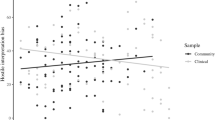Abstract
We explored the association between maternal panic-like and depression symptoms with the offspring’s separation-related interpretive bias in a community sample. Separation anxiety has been found to be a precursor of panic disorders; therefore we focused on children and adolescents’ (aged 7–14 years) interpretive bias tapping into separation concerns using a story-based task. We collected self-reports and maternal reports of the levels of separation anxiety in the offspring. To assess maternal panic-like symptoms, we measured interoceptive and agoraphobic fears; as they have been found to increase the likelihood of experiencing panic disorders. The results showed that elevated levels of maternal interoceptive fears and agoraphobia co-occurring with depression were associated with an interpretive bias that related to separation anxiety concerns in children and adolescents. Offspring whose mothers experienced elevated panic-like symptoms together with depression did not show an interpretive bias linked to generalized anxiety concerns, suggesting the bias is content specific. The clinical significance of these findings stems from giving insight as to what extent separation interpretive biases would be influenced by maternal mental health variables, as these biases could constitute a vulnerability factor for later psychopathology. Further research is merited to address the findings with a longitudinal approach.


Similar content being viewed by others
References
Acheson, D. T., Forsyth, J. P., Prenoveau, J. M., & Bouton, M. E. (2007). Interoceptive fear conditioning as a learning model of panic disorder: An experimental evaluation using 20% CO2-enriched air in a non-clinical sample. Behaviour Research and Therapy, 45, 2280–2294.
American Psychiatric Association. (2000). Diagnostic and statistical manual of mental disorders (DSM-IV-TR) (4th ed.). Washington DC: American Psychiatric Association.
Bar-Haim, Y., Lamy, D., Pergamin, L., Bakermans-Kranenburg, M. J., & van IJzendoorn, M. H. (2007). Threat-related attentional bias in anxious and nonanxious individuals: A meta-analytic study. Psychological Bulletin, 133, 1–24.
Beck, A. T., Steer, R. A., & Brown, G. K. (1996). The Beck depression inventory manual. San Antonio: The Psychological Corporation.
Biederman, J., Faraone, S. V., Hirshfeld-Becker, D. R., Friedman, D., Robin, J. A., & Rosenbaum, J. F. (2001). Patterns of psychopathology and dysfunction in high-risk children of parents with panic disorder and major depression. American Journal of Psychiatry, 158, 49–57.
Biederman, J., Monuteaux, M. C., Faraone, S. V., Hirshfeld-Becker, D. R., Henin, A., Gilbert, J., et al. (2004). Does referral bias impact findings in high-risk offspring for anxiety disorders? A controlled study of high-risk children of non-referred parents with panic disorder/agoraphobia and major depression. Journal of Affective Disorders, 82, 209–216.
Biederman, J., Petty, C., Faraone, S. V., Henin, A., Hirshfeld-Becker, D., Pollak, M. H., et al. (2006). Effects of parental anxiety disorders in children at high risk for panic disorder: A controlled study. Journal of Affective Disorders, 94, 191–197.
Biederman, J., Petty, C. R., Hirshfeld-Becker, D. R., Henin, A., Faraone, S. V., Fraire, M., et al. (2007). Developmental trajectories of anxiety disorders in offspring at high risk for panic disorder and major depression. Psychiatry Research, 153, 245–252.
Bögels, S. M., & Brechman-Toussaint, M. L. (2006). Family issues in child anxiety: Attachment, family functioning, parental rearing and beliefs. Clinical Psychology Review, 26, 834–856.
Bögels, S. M., Snieder, N., & Kindt, M. (2003). Specificity of dysfunctional thinking in children with social anxiety, separation anxiety and generalized anxiety. Behavior Change, 20, 160–169.
Bögels, S. M., & Zigterman, D. (2000). Dysfunctional cognitions in children with social phobia, separation anxiety disorder, and generalized anxiety disorder. Journal of Abnormal Child Psychology, 28, 205–211.
Brown, T. A., White, K. S., & Barlow, D. H. (2005). A psychometric reanalysis of the Albany panic and phobia questionnaire. Behavior Therapy, 43, 337–355.
Cartwright-Hatton, S., McNicol, K., & Doubleday, E. (2006). Anxiety in a neglected population: Prevalence of anxiety disorders in pre-adolescent children. Clinical Psychology Review, 26, 817–833.
Chorpita, B. F., Yim, L., Moffitt, C., Umemoto, L. A., & Francis, S. E. (2000). Assessment of symptoms of DSM IV anxiety and depression in children: A revised child anxiety and depression scale. Behaviour Research and Therapy, 38, 835–855.
Clark, D. M. (1986). A cognitive approach to panic. Behaviour Research and Therapy, 24, 461–470.
Costa, N. M., & Weems, C. F. (2005). Maternal and child anxiety: do attachment beliefs or children’s perceptions of maternal control mediate their association? Social Development, 14, 574–590.
Creswell, C., Cooper, P., & Murray, L. (2010). In J. A. Hadwin & A. P. Field (Eds.), Information processing biases and anxiety: A developmental perspective (pp. 279–296). Chichester: John Wiley & Sons, Ltd.
Dadds, M. R., & Roth, J. H. (2001). Family processes in the development of anxiety disorders. In M. Vasey & M. R. Dadds (Eds.), The developmental psychopathology of anxiety (pp. 278–303). Oxford: Oxford University Press.
De Los Reyes, A., & Kazdin, A. E. (2005). Informant discrepancies in the assessment of childhood psychopathology: A critical review, theoretical framework, and recommendations for further study. Psychological Bulletin, 131, 483–509.
Dick-Niederhauser, A., & Silverman, W. K. (2006). Separation anxiety disorder. In J. E. Fisher & W. T. O’ Donohue (Eds.), Practitioner’s guide to evidence based-psychotherapy (pp. 627–633). New York: Springer Science and Business Media.
Ehrenreich, J. T., Santucci, L. C., & Weiner, C. (2008). Separation anxiety disorder in youth: Phenomenology, assessment and treatment. Psicología Conductual, 16, 389–412.
Elgar, F. J., McGrath, P. J., Waschbusch, D. A., Stewart, S. H., & Curtis, L. J. (2004). Mutual influences on maternal depression and child adjustment problems. Clinical Psychology Review, 24, 441–459.
Hadwin, J. A., Garner, M., & Perez-Olivas, G. (2006). The development of information processing biases in childhood anxiety: A review and exploration of its origins in parenting. Clinical Psychology Review, 26, 876–894.
Hirshfeld-Becker, D. R., Micco, J. A., Simoes, N. A., & Henin, A. (2008). High risk studies and developmental antecedents of anxiety disorders. American Journal of Medical Genetics Part C: Seminars in Medical Genetics, 148, 99–117.
In-Albon, T., Dubi, K., Rapee, R. M., & Schneider, S. (2009). Forced choice reaction time paradigm in children with separation anxiety disorder, social phobia and nonanxious controls. Behaviour Research and Therapy, 47, 1058–1065.
In-Albon, T., Klein, A., Rinck, M., Becker, E., & Schneider, S. (2008). Development and evaluation of a new paradigm for the assessment of anxiety disorder-specific interpretation bias using picture stimuli. Cognition and Emotion, 22, 422–436.
In-Albon, T., Kossowsky, J., & Schneider, S. (2010). Vigilance and avoidance of threat in the eye movements of children with separation anxiety disorder. Journal of Abnormal Child Psychology, 38, 225–235.
Jurbergs, N., & Ledley, D. R. (2005). Separation anxiety disorder. Pediatric Annals, 34, 108–115.
Kagan, J., Snidman, N., McManis, M., Woodward, S., & Hardway, C. (2002). One measure, one meaning: Multiple measures, clearer meaning. Development and Psychopathology, 14, 463–475.
Lasa, L., Ayuso-Mateos, J. L., Vazquez-Barquero, J. L., Diez-Manrique, F. J., & Dowrick, C. F. (2000). The use of the Beck depression inventory to screen for depression in the general population: A preliminary analysis. Journal of Affective Disorders, 57, 261–265.
Lipsitz, J. D., Martin, L. Y., Mannuzza, S., Chapman, T. F., Liebowitz, M. R., Klein, D. F., et al. (1994). Childhood separation anxiety disorder in patients with adult anxiety disorders. American Journal of Psychiatry, 151, 927–929.
Muris, P., & Field, A. P. (2008). Distorted cognition and pathological anxiety in children and adolescents. Cognition and Emotion, 22, 395–421.
Muris, P., Luermans, J., Merckelbach, H., & Mayer, B. (2000a). “Danger is lurking everywhere”. The relation between anxiety and threat perception abnormalities in normal children. Journal of Behaviour Therapy and Experimental Psychiatry, 31, 123–136.
Muris, P., Merckelbach, H., & Damsma, E. (2000b). Threat perception bias in nonreferred, socially anxious children. Journal of Clinical Child Psychology, 29, 348–359.
Muris, P., Vermeer, E., & Horselenberg, R. (2008). Cognitive development and the interpretation of anxiety-related physical symptoms in 4–13 year old non-clinical children. Journal of Behavior Therapy and Experimental Psychiatry, 39, 73–86.
Perez-Olivas, G., Stevenson, J., & Hadwin, J. A. (2008). Do anxiety-related attentional biases mediate the link between maternal over involvement and separation anxiety in children? Cognition and Emotion, 22, 509–521.
Rapee, R. M., Craske, M. G., & Barlow, D. H. (1994). Assessment instrument for panic disorder that includes fear of sensation-producing activities: The Albany panic and phobia questionnaire. Anxiety, 1, 114–122.
Santucci, L. C., Ehrenreich, J. T., Trosper, S., Bennett, S. M., & Pincus, D. B. (2009). Development and preliminary evaluation of a one-week summer treatment program for separation anxiety disorder. Cognitive & Behavioral Practice, 16, 317–331.
Schneider, S., Unnewehr, S., Florin, I., & Margraf, J. (2002). Priming panic interpretations in children of patients with panic disorder. Journal of Anxiety Disorders, 16, 605–624.
Schniering, C. A., & Rapee, R. M. (1997). A test of the cognitive model of panic: Primed lexical decision in panic disorder. Journal of Anxiety Disorders, 11, 557–571.
Stirling, L., Eley, T. C., & Clark, D. M. (2006). Avoidance of negative faces and social anxiety in children. Journal of Clinical Child & Adolescent Psychology, 35, 440–445.
Teachman, B. A., Smith-Janik, S. B., & Saporito, J. (2007). Information processing biases and panic disorder: Relationships among cognitive and symptom measures. Behaviour Research and Therapy, 45, 1791–1811.
Unnewehr, S., Schneider, S., Florin, I., & Margraf, J. (1998). Psychopathology in children of patients with panic disorder or animal phobia. Psychopathology, 31, 69–84.
Acknowledgments
We would like to thank all the families and children that took part in the study. We would also like to thank the Economic Social and Research Council (E.S.R.C) for funding the study.
Author information
Authors and Affiliations
Corresponding author
Rights and permissions
About this article
Cite this article
Perez-Olivas, G., Stevenson, J. & Hadwin, J.A. The Association Between Elevated Maternal Panic-Like and Depression Symptoms and Separation-Related Interpretive Biases in Offspring. J Child Fam Stud 20, 232–239 (2011). https://doi.org/10.1007/s10826-010-9408-1
Published:
Issue Date:
DOI: https://doi.org/10.1007/s10826-010-9408-1




